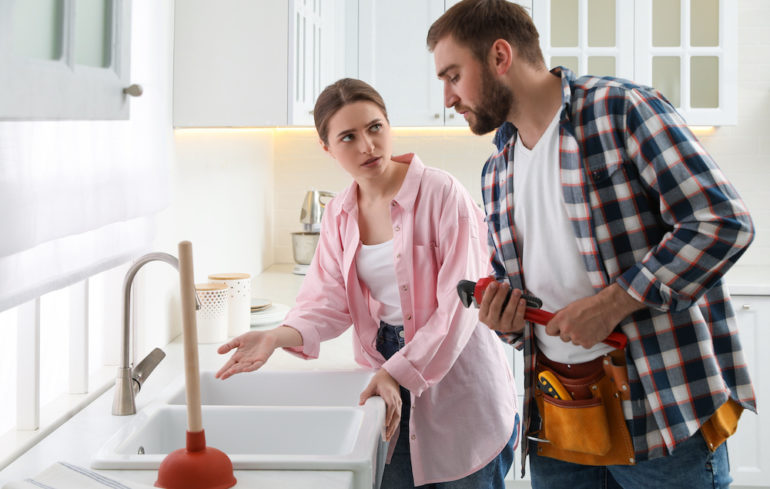What a headache! A clogged drain is nasty and messy, and the timing is never good. Let’s look at what to do when you have a clog and how to prevent them.
Types of clogged drains and their causes
Kitchen clogs can occur in the sink, disposal and sometimes the dishwasher. All three types of clogs are usually caused by the accumulation of food particles and grease. Food or grease gets clogged in the bottom of the “P-trap” below the sink and prevents it from draining. The disposal gets overwhelmed and bogs down, particularly if you try to grind fibrous foods. The drain at the bottom of the dishwasher clogs with food particles if dishware is not rinsed thoroughly before loading.
In the bathroom, clogs affect the sink, toilet, and shower and/or bathtub. The cause in the sink is hair that falls when users groom before the mirror. The hair binds into clumps when soap scum accumulates. Hair and soap also account for most clogs in the shower or bathtub. Inadequate water flow from low-flush toilet tanks can cause toilet clogs, as can flushing cotton swabs, feminine products or other objects beyond toilet paper.
Beyond the house
Sometimes clogs occur in the main drain line that runs in your yard between the house and the sewer or septic system. When this happens, you may experience backups in several of your home’s drains at once. The cause of these clogs is usually a crack or collapse in the main drain line. Clogs can also occur when tree roots penetrate a joint in this drain line. You’ll need a professional plumber to clear these clogs. The plumber will run a camera “snake” into the line to locate the problem and then a steel cable snake to unclog it. If the main line is cracked or collapsed, you will have to replace it.
Clearing household clogs yourself
Clear a bathroom sink or a shower or tub drain that’s clogged with hair and soap by removing the drain cover and using needle-nose pliers to pull out the clumps. Replace the cover, and the drain should flow smoothly again.
A plunger clears many common toilet clogs. Make sure you use the correct style. Sink plungers have a simple bell-shaped rubber cup. Toilet plungers have an additional rubber sleeve on the bottom, called a flange, which provides the extra seal needed to clear a toilet clog.
Chemical cleaners
You can also try to clear a drain with a chemical cleaner. There are three types.
- Caustic cleaners such as Drano use lye or other corrosive chemicals to dissolve the source of the blockage. These cleaners work best on grease but can also dissolve hair and food particles. It’s advisable to wear safety glasses and a breathing mask when using a caustic cleaner. These cleaners can harm septic systems.
- Oxidizing cleaners such as Liquid Plumr work best on hair and food but not as well on grease. These cleaners use chemical reactions to create heat in the toilet bowl and plumbing. These cleaners can also harm septic systems.
- Enzymatic and bacterial cleaners are safer than caustic and oxidizing types. These products use natural processes to break down the source of the clog. They are also safer for septic systems, particularly bacterial cleaners.
Preventing clogged drains
To avoid clogs in the first place, remember these dos and don’ts.
- Don’t pour grease down the kitchen sink. It will cool, congeal and plug the drain’s P-trap. Instead, pour it into a can and put it in the trash.
- Do prerinse food particles from dishes before placing them in the dishwasher to prevent clogs in its drain.
- Don’t grind fibrous vegetables or fruits in the disposal. Instead, collect fruit and vegetable scraps in a bucket and dump them into an outside compost bin.
- Do install drain screens in the bathroom sink and the tub and/or shower.
- Don’t flush cotton swabs, dental floss, feminine products, baby wipes or other bulky items down the toilet.
- Do help prevent toilet clogs by occasionally pouring a five-gallon pail of water down the bowl while flushing. This will forcefully clear the drain’s P-trap.
Related – Hiring a Plumber


